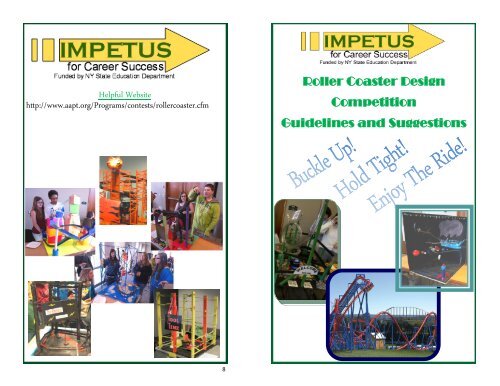Create successful ePaper yourself
Turn your PDF publications into a flip-book with our unique Google optimized e-Paper software.
Helpful Website<br />
http://www.aapt.org/Programs/contests/rollercoaster.cfm<br />
<strong>Roller</strong> <strong>Coaster</strong> Design<br />
Competition<br />
Guidelines and Suggestions<br />
8
Table of Contents Page<br />
I. Timeline 3<br />
II. Monthly Activities<br />
September<br />
4<br />
October 4<br />
November 5<br />
December 5<br />
January 5<br />
February 6<br />
March 6<br />
April 7<br />
III. Resources<br />
a) Rules and Regulations 7<br />
b) Competition Contacts 8<br />
A highlight of the Clarkson STEP Program is the annual <strong>Roller</strong> <strong>Coaster</strong><br />
Design Competition. The main purpose of this brochure is help teams in<br />
building a unique and prize-worthy roller coaster to showcase at the<br />
competition. On the following pages you will find a suggested timeline,<br />
contest rules, point system, and pictures from previous years. Have fun!<br />
“<br />
“Competition”<br />
The show is ON so it is time to show OFF your hard work.<br />
Avoid disappointment by knowing and following the rules.<br />
Here is a sample rubric. Check for updates.<br />
<strong>Coaster</strong><br />
Rule C A<br />
ball must<br />
be<br />
provided by the team on judging day. The ball must be either a<br />
glass marble of regular size or greater, or a steel ball that is 1<br />
cm (1/2") in diameter or greater.<br />
<strong>Coaster</strong> Rule D Magnets, electricity, springs and other forms of<br />
energy may not be used. This is a "gravity ride" only. These other sources of energy can<br />
be used for esthetics (i.e., background lighting). No electricity is provided in the contest<br />
area.<br />
<strong>Coaster</strong> Rule E The start position at the top of the first hill must be marked. The steel<br />
ball or glass marble must end in a designated area or container.<br />
2<br />
7
“Design & Support”<br />
Timeline<br />
The roller coaster design<br />
does not stop at the first hill.<br />
In fact it is just beginning.<br />
Based on the sketches made<br />
in November, what’s next?<br />
Loops? Twist? Turns?<br />
How will your roller coaster<br />
progressively decrease in<br />
elevation? More importantly<br />
how will this design be supported? Now is the time to<br />
find what works in supporting your structure.<br />
<strong>Coaster</strong> Rule B The model should be designed for a<br />
steel ball or glass marble. This means that the steel ball<br />
or glass marble when released from the top of the first<br />
hill by the judge will travel through the entire ride to<br />
arrive at the bottom loading platform. (Note: For this<br />
contest, you will raise the steel ball or glass marble by<br />
hand from the loading platform to the top of the first<br />
hill to start the "ride".)<br />
September<br />
Jumpstart Discussion<br />
Introduction to Project<br />
November<br />
Material & Sketches<br />
January<br />
Initial Hill & Stunt<br />
Designs<br />
March<br />
Decorate Your <strong>Coaster</strong><br />
October<br />
Discuss Possible<br />
Themes & Build Base<br />
December<br />
Intermission/Break<br />
February<br />
Design of Support<br />
Structure<br />
April<br />
Competition!<br />
“Decorations”<br />
Pat yourselves on the back! The structure of your roller<br />
coaster should be complete, now it’s time to bring out<br />
your theme!!!<br />
6<br />
3
“Jumpstart Discussion & Introduction to Project”<br />
The year has just begun, September is a great time to<br />
brainstorm ideas for themes and designs.<br />
Discussion Questions:<br />
What is your favorite roller coaster?<br />
What themes could you have?<br />
What is your favorite movie/show/game/food?<br />
What supplies should you be on the lookout for?<br />
Remember the possibilities are endless, but narrowing<br />
down to a few great ideas will help the process rum<br />
smoothly.<br />
“Theme & Base Cut”<br />
By October the questions should have switched from<br />
“what to do?” to “how to make it happen?” A theme<br />
should be determined by this time and you can begin to<br />
build the regulation sized base.<br />
<strong>Coaster</strong> Rule A<br />
Size restrictions - the base must fit<br />
within a square footprint that is 75 cm x<br />
75 cm. The overall track must fit within<br />
a rectangular box 75 cm x 75 cm x 100<br />
cm high, including all decorations.<br />
“Material & Sketches”<br />
Now it’s time to brainstorm your theme and how it will<br />
be incorporated into the roller coaster.<br />
Guiding Questions:<br />
What should the roller coaster look like?<br />
What materials should you use?<br />
What materials do you have access to?<br />
Draw a few sketches and narrow down to one design<br />
that can be done with the materials you have access to.<br />
“Intermission”<br />
Due to the numerous activities during the holiday<br />
season excitement, December can be used to collect<br />
supplies (gift wrapping paper rolls, boxes, paper) and<br />
review your plan!<br />
“Biggest Hill”<br />
The entire potential of your rollercoaster is dependent<br />
on the first hill and gravity.<br />
Q:Why is the first hill on a roller coaster the highest<br />
hill on the entire ride?<br />
A:The first hill on a roller coaster is the biggest<br />
because it will need enough speed the ride. The initial<br />
height is an important measurement. If the first hill is<br />
too big the car may fall off the track, if it is too short the car may<br />
not be able to finish the ride.<br />
4<br />
5

















